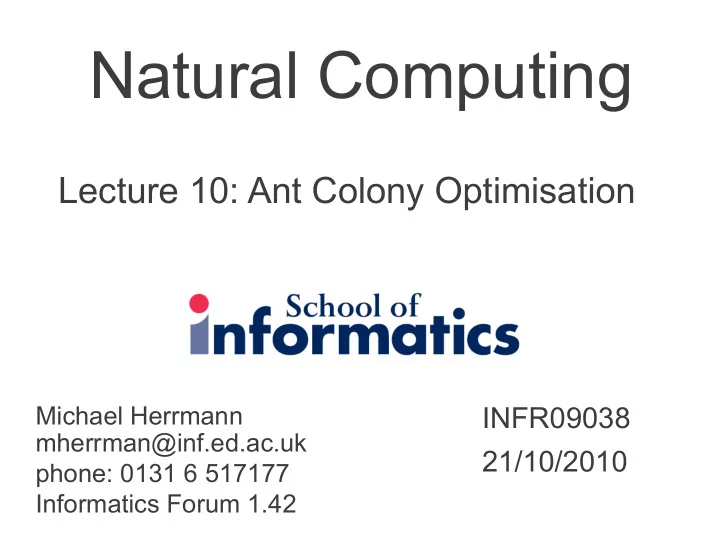

Natural Computing Lecture 10: Ant Colony Optimisation Michael Herrmann INFR09038 mherrman@inf.ed.ac.uk 21/10/2010 phone: 0131 6 517177 Informatics Forum 1.42
蚁群算法 Marco Dorigo (1992). Optimization, Learning and Natural Algorithms. Ph.D.Thesis , Politecnico di Milano, Italy, in Italian. “ The Metaphor of the Ant Colony and its Application to Combinatorial Optimization” Based on theoretical biology work of Jean-Louis Deneubourg (1987) From individual to collective behavior in social insects . Birkhäuser Verlag, Boston.
Picture from http://www.scs.carleton.ca/~arpwhite/courses/95590Y/notes/SI%20Lecture%203.pdf
Stigmergy in Humans stigma (mark, sign) + ergon (work, action) Pierre-Paul Grassé (1959)
Applications ● Bus routes, garbage collection, delivery routes ● Machine scheduling: Minimization of transport time for distant production locations ● Feeding of lacquering machines ● Protein folding ● Telecommunication networks: Online optimization ● Personnel placement in airline companies ● Composition of products
? Byung-In Kim & Juyoung Wy Int J Adv Manuf Technol (2010) 50:1145–1152 (this is only the motivating example in this study)
possibly
Some general considerations Best ant laying pheromone (global-best ant or, in some versions of ACO, iteration-best ant) encourage ants to follow the best tour or to search in the neighbourhood of this tour (make sure that τ min >0). Local updating (the ants lay pheromone as they go along without waiting till end of tour). Can set up the evaporation rate so that local updating “eats away” pheromone, and thus visited edges are seen as less desirable, encourages exploration. (Because the pheromone added is quite small compared with the amount that evaporates.) Heuristic improvements like 3-opt – not really “ant”-style “Guided parallel stochastic search in region of best tour” [Dorigo and Gambardella], i.e. assuming a non-deceptive problem.
Vehicle routing problems A.E. Rizzoli, · R. Montemanni · E. Lucibello · L.M. Gambardella (2007) Ant colony optimization for real-world vehicle routing problems. Swarm Intelligence 1 : 135–151
Vehicle routing problems E.g. distribute 52000 pallets to 6800 customers over a period of 20 days Dynamic problem: continuously incoming orders Strategic planning: Finding feasible tours is hard Computing time: 5 min (3h for human operators) More tours required for narrower arrival time window Implicit knowledge on traffic learned from human operators A.E. Rizzoli, · R. Montemanni · E. Lucibello · L.M. Gambardella (2007) Ant colony optimization for real-world vehicle routing problems. Swarm Intelligence 1 : 135–151
ACO algorithm init best-so-far solution set of valid solutions loop over ants update best-so-far store valid solutions
Negative pheromones in real ants Robinson EJ, Jackson DE, Holcombe M, Ratnieks FL (2005) Insect communication: 'no entry' signal in ant foraging. Nature . 438 :7067, 442. Abstract: Forager ants lay attractive trail pheromones to guide nestmates to food, but the effectiveness of foraging networks might be improved if pheromones could also be used to repel foragers from unrewarding routes. Here we present empirical evidence for such a negative trail pheromone, deployed by Pharaoh's ants (Monomorium pharaonis) as a 'no entry' signal to mark an unrewarding foraging path. This finding constitutes another example of the sophisticated control mechanisms used in self-organized ant colonies.
References on Ant Colony Optimization ● M. Dorigo & T. Stützle, Ant Colony Optimization, MIT Press, 2004. ● M. Dorigo & T. Stützle, The Ant Colony Optimization Metaheuristic: Algorithms, Applications, and Advances, Handbook of Metaheuristics, 2002. http://iridia.ulb.ac.be/ %7Estuetzle/publications/ACO.ps.gz ● M. Dorigo, Ant Colony Optimization. Scholarpedia, 2007. ● T. Stützle and H. H. Hoos, MAX-MIN Ant System. Future Generation Computer Systems. 16(8):889--914,2000. http://iridia.ulb.ac.be/%7Estuetzle/publications/FGCS.ps.gz
Recommend
More recommend